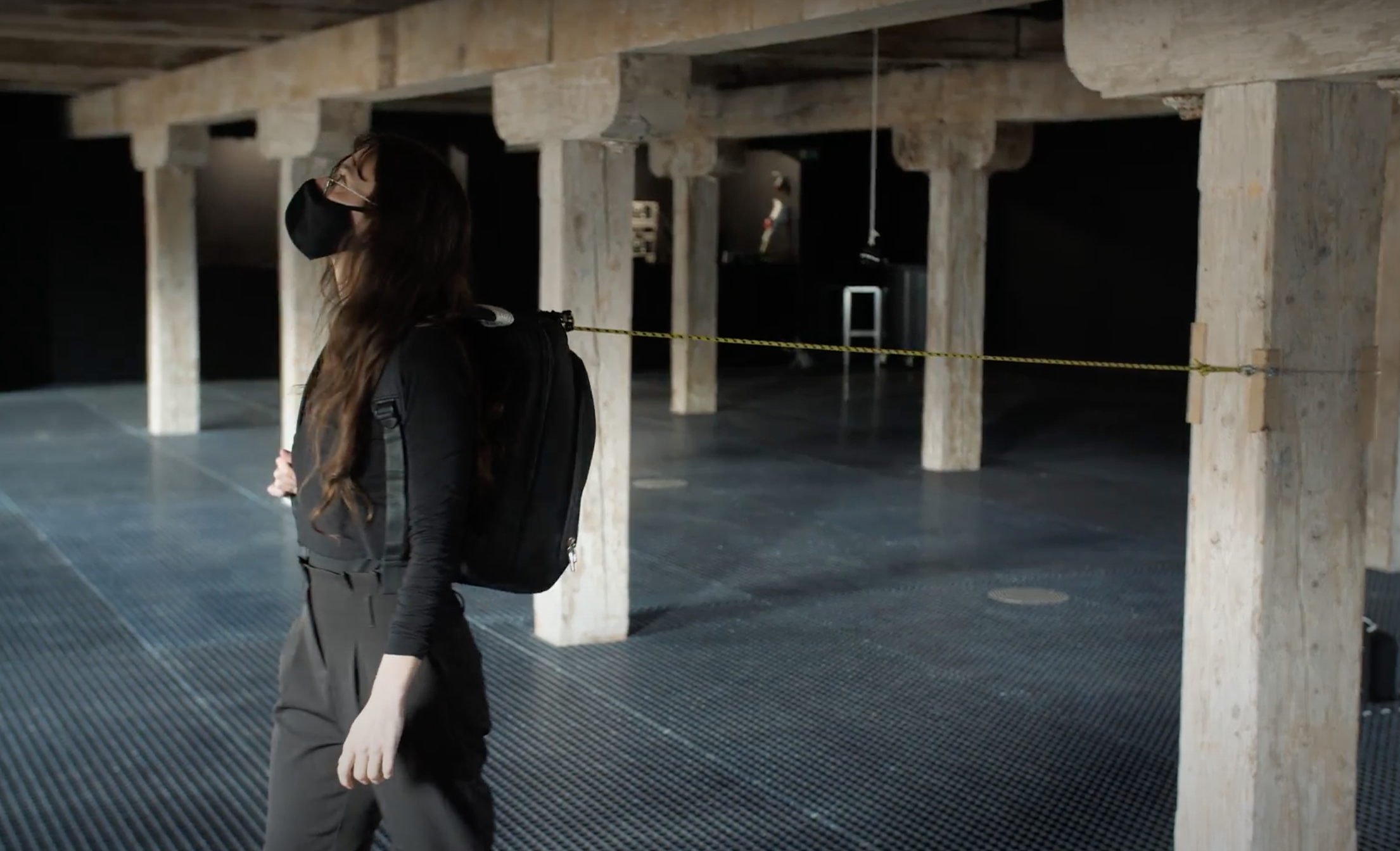Attunement
(2021)
Cat Lamoureux
Attunement means to bring into harmony, but also to become more aware, responsive.
Attunement is an interactive immersive installation developed by Cat Lamoureux (a.k.a. Valeda) where participants can activate and modify a palette of sounds and textures in order to co-create an evolving and responsive sonic environment. Four position trackers, each linked to a distinct element of the composition, are placed around the room, waiting to be moved, swung, carried, and even worn. This installation seeks to encourage curiosity and play, while allowing participants to involve their bodies in an active experience of listening.
The composition was created at SSI, and each sound was chosen and crafted while keeping in mind the way it would be altered by participants. For example, there is an analogous relationship between the motion of the position tracker that is suspended from the ceiling like a pendulum and the bell-like midi notes that are activated when it is swung. Similarly, one of the trackers is placed within a backpack which is itself attached by a bungee cord to a pillar, allowing the participant to wear the backpack and to hear a swirling crackling sound that becomes more intense, overwhelming, and loud as the participant struggles to move away from the centre point of the pillar, the sound mirroring this tension. A small suitcase contains the third tracker, and as it is moved away from the centre of the room, the drone-like pads connected to the tracker slowly become more airy, light, shifting from a more static and perhaps darker space to a more expansive, dynamic, hopeful one. The last tracker can be slid along a long rope that runs between two beams overhead, and is connected to both a steady subkick and to the overall BPM of the entire composition. As the tracker is moved along this trajectory, the visceral subkick gets louder and faster as the rest of the composition is simultaneously sped up.
Attunement aims to emphasize the importance in recognizing the infinitely diverse and unique ways in which individuals respond to sound, and, more largely, to their environment. One participant might be drawn to altering the composition in a completely different way from someone else, just as someone might feel more at ease in a chaotic, bustling environment while someone else may respond more positively to a more quiet, softer space.
How can spatial sound be used as a tool for people (particularly neurodivergent adults and children) to explore their bodies’ responses to sound and space?
Reflecting on the importance of attunement can allow us to create safer and more conducive learning environments, and opening up new avenues for play and exploration can allow people to communicate about emotional states when language doesn’t feel accessible or adequate.
Attunement is an interactive immersive installation developed by Cat Lamoureux (a.k.a. Valeda) where participants can activate and modify a palette of sounds and textures in order to co-create an evolving and responsive sonic environment. Four position trackers, each linked to a distinct element of the composition, are placed around the room, waiting to be moved, swung, carried, and even worn. This installation seeks to encourage curiosity and play, while allowing participants to involve their bodies in an active experience of listening.
The composition was created at SSI, and each sound was chosen and crafted while keeping in mind the way it would be altered by participants. For example, there is an analogous relationship between the motion of the position tracker that is suspended from the ceiling like a pendulum and the bell-like midi notes that are activated when it is swung. Similarly, one of the trackers is placed within a backpack which is itself attached by a bungee cord to a pillar, allowing the participant to wear the backpack and to hear a swirling crackling sound that becomes more intense, overwhelming, and loud as the participant struggles to move away from the centre point of the pillar, the sound mirroring this tension. A small suitcase contains the third tracker, and as it is moved away from the centre of the room, the drone-like pads connected to the tracker slowly become more airy, light, shifting from a more static and perhaps darker space to a more expansive, dynamic, hopeful one. The last tracker can be slid along a long rope that runs between two beams overhead, and is connected to both a steady subkick and to the overall BPM of the entire composition. As the tracker is moved along this trajectory, the visceral subkick gets louder and faster as the rest of the composition is simultaneously sped up.
Attunement aims to emphasize the importance in recognizing the infinitely diverse and unique ways in which individuals respond to sound, and, more largely, to their environment. One participant might be drawn to altering the composition in a completely different way from someone else, just as someone might feel more at ease in a chaotic, bustling environment while someone else may respond more positively to a more quiet, softer space.
How can spatial sound be used as a tool for people (particularly neurodivergent adults and children) to explore their bodies’ responses to sound and space?
Reflecting on the importance of attunement can allow us to create safer and more conducive learning environments, and opening up new avenues for play and exploration can allow people to communicate about emotional states when language doesn’t feel accessible or adequate.
Photo credits : Mladin Bence
related:
